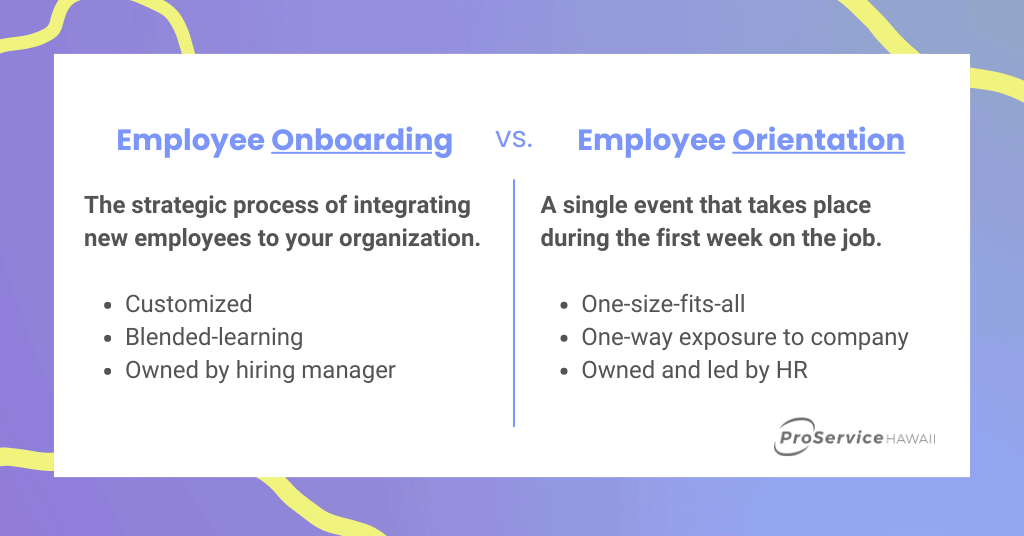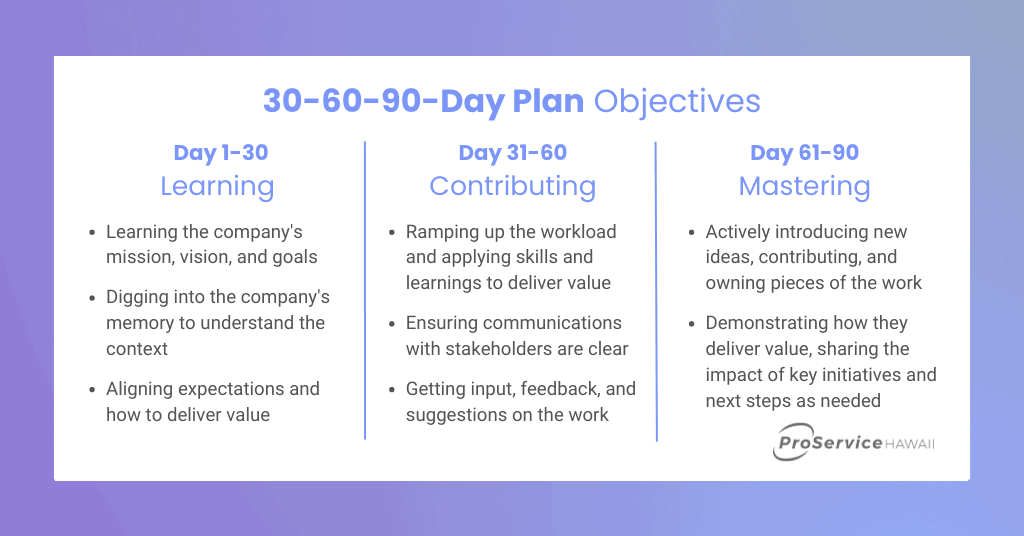How to Onboard Remote Workers in Hawaii
Tips for onboarding remote workers, from what to do before their first day, to 30-60-90 day plans, the buddy system approach, and more!
Now that the pandemic has normalized remote work and new technologies have emerged, Hawaii companies have widened their talent pools and are hiring people on the mainland to work remotely more easily than ever before. But now, a new problem has surfaced. How do businesses effectively integrate remote employees into their work culture and organization? How do managers ensure their teams work well together even if they're not all in the same office? It all starts with rethinking the employee onboarding experience for remote workers.
As you might imagine, onboarding a remote employee from across the Pacific Ocean is different from onboarding someone who lives and works in Hawaii. There are unique challenges and obstacles to overcome. This blog post will explore a few of these onboarding challenges and what Hawaii employers can do to better integrate remote workers with their in-person colleagues…starting from day one!
What is employee onboarding?
Employee onboarding is the strategic process of integrating employees into the organization. Too often, managers mistake employee orientation for onboarding, so let's quickly examine and review the differences. Employee orientation is a single event during the first week of the job. It's usually one-size-fits-all and is owned and led by HR. Meanwhile, onboarding delivers role-based information to employees and is a process that's typically owned by the hiring manager.

What is the goal of employee onboarding?
Whether you manage an entirely in-person team, remote workforce, or a combination of both, the goals of onboarding a new hire are the same regardless of where work gets done. They include helping your new employee:
- Quickly learn the ropes
- Build strong relationships
- Understand company culture
- Recognize team norms and expectations
- Contribute, lead, and take ownership of their role and work
But while the goals are the same, the onboarding experience can vary depending on where employees work, even from day one.
The Disparity from Day One
Let's examine the hypothetical story of two new hires, Emily and Michelle. Emily and Michelle are new hires at a marketing firm based in downtown Honolulu and will start on the same day. Emily is an SEO wizard and digital specialist from Seattle, while Michelle is a marketing generalist of similar age and experience who will be working from the agency's Honolulu office.

Consider both of their first days. On Michelle's first day, she goes into the office to meet her co-workers for the first time. On her way to work, she stops by Leonard's Bakery to pick up a box of malasadas to share with her new team. While IT helps her get situated at her permanent desk, her teammates hang around her cubicle. They eat hot malasadas, give her company swag gifts, and exchange small talk, which includes work-related tips Michelle should know about. At 8:30 am, they all head to the conference room for their morning huddles, where they will meet their new colleague Emily from Seattle. Now let's compare and contrast Emily's first day of work – and how it might look differently.
On the same morning, three hours earlier on Pacific Time, Emily makes her way from her bedroom to her home office. At 8 am, she unboxes the laptop she received from the agency in the mail the previous day. Once she's managed to log in, she reads an email from her Hawaii manager with the subject line, “Welcome, Emily!” The email details her first week, the tools and platforms she'll need to ramp up on, and includes a lengthy bulleted list of things to know and documents she needs to read. Emily reads and re-reads the email to ensure she's absorbed everything before logging into Zoom to meet her new team virtually.
Business leaders must understand that remote workers will face unique challenges during onboarding and throughout their tenure with your organization. By 8:30 am, Michelle is already interacting with half a dozen co-workers and beginning to pick up on company culture cues. Half an hour into the workday, Emily is already at a disadvantage — she's dependent on scheduled Zoom meetings to engage her co-workers and lots of written documentation to sort through on her own. This is just one example of remote workers' difficulties when most of their co-workers are in-person or hybrid.

Now let's quickly consider John, a remote manager in California. John is an engineer who is responsible for managing a team of people in Hawaii. The role of a remote manager is even more challenging as they need to understand the company culture and lead their team through it.
For John, as a leader, his challenges might include:
- Building trust and rapport with his direct reports virtually
- Managing processes and productivity from a distance
- Ensuring that his team understands his leadership style and expectations
- Building strong working relationships with other leaders in the company that are mostly in-person
So, what can Hawaii businesses do to help remote workers integrate and succeed in their new roles? Here are three ideas (and a bunch of tips) you can use to help you get started.
Improving Employee Onboarding When You're Apart
#1 Preparing for the Onboarding Process
The first step in onboarding a remote employee is preparing for your new hire's arrival. This includes mailing all the necessary hardware and equipment (i.e., laptops, monitors, etc.) they'll need to do their jobs and ensure they have access to the software and user accounts to online platforms your team regularly uses.
Pro-Tips:
- Swag it up: Don't just mail them their laptops. Mail branded swag to remote employees, also. Include things like branded notebooks, pens, and more significant ticket items like t-shirts/hoodies, coffee mugs, folders, etc.
- Share the aloha spirit: Encourage their manager and/or in-person team to find their new remote colleague on LinkedIn and send them welcome messages before their first day.
- Get your tech in order: Work with your IT team to document FAQs from a new hire's perspective, from setting up their laptop and getting work email on their devices (if required) to providing them with a tools and platform cheat sheet so they might start learning what resources are available to them to be masters at their work.
#2. Update Your 30-60-90-Day Plan
Creating a 30-60-90 day plan can help your remote employee start quickly and provide structure for their first few months. This plan should include specific goals, milestones, and expectations for their role. If you intend to have your new hire work on a particular project, scope out the assignment or deliverable in advance and provide enough detail for them to dive into the work.

Already have a general 30-60-90 day template for onsite workers? Consider the small adjustments you can make to your existing plan to better support new hires by considering the top 10 challenges they face:
- Lack of face-to-face interaction and building relationships with co-workers
- Difficulty adapting to new company culture and norms
- Technical problems and lack of access to resources
- Isolation and feeling disconnected from the team
- Difficulty communicating and collaborating with remote team members
- Fewer opportunities for in-person training and coaching
- Time Zone differences and difficulties with scheduling
- Challenges in establishing clear expectations and roles
- Unfamiliarity with remote work tools and technology
- Difficulty finding a balance between work and personal life
Pro-Tips:
- Bring the team together: Fostering togetherness is essential, especially when you have a distributed team. If your budget allows, consider inviting your new hire to Hawaii for one to two weeks of planning and immersion with your broader team. During these critical weeks, schedule important planning meetings with your team in person along with team building activities from after-hour pau-hanas to half-day offsite activities like volunteering together at a local non-profit.
- Reimagine collaboration: Often, team collaboration occurs while standing around a physical whiteboard, but this setup could do a better job of including your remote employees. Consider investing in a digital whiteboard for your office. Encourage collaboration between onsite and remote workers by making it easier to whiteboard when teams are distributed. Tools like Jamboard or Lucidspark are excellent options for sparking creativity and conversation with in-person and remote contributors.
- Schedule virtual huddles: If your workplace is fast-paced and constantly evolving, you should find remote-friendly solutions for promptly informing people. In addition to leveraging project management tools like Asana or Monday.com, one idea to try is scheduling structured information-sharing meetings between key in-person and remote work contributors. These syncs can be quick (e.g., 15 minutes or less), and the frequency can vary (e.g., daily or bi-weekly). Ultimately, these quick huddles can help everyone stay current with details or conversations that even the best project management tools can only partially capture.
#3. Implement a Buddy System
Implementing a buddy system is a practical approach for integrating remote workers into an organization's culture and overcoming the challenges of remote work. This system pairs a new remote worker with a Hawaii-based peer or mentor who can serve as a guide and resource. A buddy system can be a great way to help remote workers feel connected and integrated into your company and team culture. Not only does having a designated person to turn to for questions and support help them navigate their new role, but by having regular check-ins and interactions with their buddy, remote workers can build relationships with their local peers and better understand the team dynamics. This can help remote workers feel more connected to their team, even when they are physically apart.
Final Thoughts
As remote work becomes increasingly prevalent in Hawaii, businesses need to consider improving their new hire onboarding process for remote workers. By taking into account the unique challenges that remote workers face, companies can help ensure that they get off to a fast start, build relationships, understand the company culture, and recognize expectations.
The benefits of improving the onboarding process for remote workers are numerous. Not only does it lead to higher employee satisfaction and engagement, but it also results in improved retention rates and increased productivity. In fact, according to one study, employees are 69% more likely to stay with a company for three years if they experience a great onboarding process. With this in mind, it's clear that investing in a successful onboarding process for remote workers is a wise business decision. By implementing best practices, such as a well-planned 30-60-90 day plan, utilizing a buddy system, and regularly checking in with remote workers, businesses can ensure that their remote employees feel valued, connected, and integrated into the company culture.







![Basic Employee Benefit Terms Every New Hire Should Know [Email Template]](https://www.proservice.com/wp-content/uploads/2022/10/Basic-Benefit-Terms-Every-New-Hire-Should-Know-Email-Template.png)

